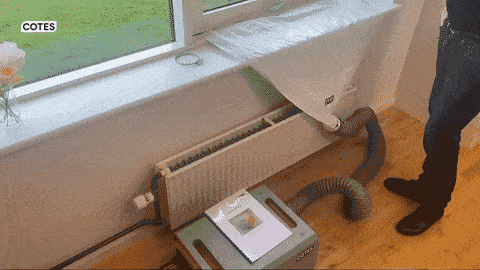Why are adsorption-based dehumidifier the best choice for drying out after water damage compared to condensation-based dehumidifiers?
In Northern Europe, the goal for dehumidifiers in water damage restoration typically is to create an environment with the target condition of 30-50% relative humidity (RH) at a room temperature of 20°C. This optimal humidity range is crucial for effective drying and preventing further damage.
Read about the reason here: Optimal Humidity Range for Water Damage Restoration: 30-50%
Dehumidification Principles
When restoring a water-damaged area, the dehumidifier should quickly achieve the target humidity range. The incoming air to the dehumidifier will be within this RH and temperature range, making the dehumidifier's performance at these conditions essential.
Video explaining the dew point and how condensation occurs
Condensation Dehumidifiers
Condensation dehumidifiers work by cooling the air below its dew point, causing moisture to condense into water droplets. To dry a room at 20°C with 40% RH, the dehumidifier must cool the air to 6°C, the dew point, before any condensation occurs. This process is energy-intensive and inefficient because:
- The initial cooldown is a significant energy loss.
- Further cooling is needed to release more water.
- There's a risk of the system freezing as temperatures approach the freezing point.
Condensation dehumidifiers are often rated for 30°C and 80% RH, where they are highly efficient. However, at 20°C and 40% RH, their capacity drops by about 80-85% (if they work at all), making them impractical for water damage restoration in cooler and less humid conditions.
Adsorption Dehumidifiers
Adsorption dehumidifiers, on the other hand, use silica gel to absorb moisture. This method is more efficient for water damage restoration because:
- Effective at Low Temperatures and Humidity: Adsorption dehumidifiers maintain performance in lower temperature and humidity conditions, unlike condensation dehumidifiers.
- Energy Efficiency: They don't require extensive cooling, saving energy and avoiding the risk of freezing.
- Consistent Performance: Silica gel acts like a water molecule magnet, absorbing moisture and releasing it with (warm), dry air.
An advantage of this principle is that it works at very low temperatures. Cotes has dehumidifiers standing in freezing houses at -30°C without problems.
The capacity of a desiccant dehumidifier is usually given at 20°C and 60% RH. The capacity of a CL26 will be 20% less at 20°C and 40% RH, meaning you will still have a lot of capacity at the target condition.
Video explaining how an adsorption dehumidifier works
For water damage restoration, especially in conditions typical of Northern Europe, adsorption-based dehumidifiers outperform condensation-based ones. They achieve the desired 30-50% RH more efficiently and reliably, making them the preferred choice for professionals in the damage service industry.
Comparing Capacities at Target Conditions
To effectively address water damage in a 100m³ room, a dehumidifier with a capacity of 0.6 to 0.9 litres per hour (l/h) at room conditions (20°C and 40% Relative Humidity - RH) is required, adjusted based on the extent of the damage*.
Desiccant dehumidifiers are typically specified at 20°C and 60% RH. Hence, to ensure sufficient capacity at the target conditions (20°C and 40% RH), a capacity of 0.7 to 1.1 l/h is recommended.
In contrast, condensation dehumidifiers are specified at 30°C and 80% RH. Therefore, to achieve the necessary capacity at the target conditions (20°C and 40% RH), a capacity of 2.8 to 3.7 l/h is needed.
However, some condensation dehumidifiers struggle to operate efficiently at low relative humidity and/or low temperatures. It's essential to inquire about the dehumidifier's performance under the target conditions if the datasheet doesn't provide capacity information for those conditions.
Energy Efficiency:
Regardless of placement and dehumidification level, dehumidifiers consume a similar amount of energy. Placing a condensation dehumidifier in the target condition (with reduced capacity by 80-85%) results in poor energy efficiency.
Conclusion:
While condensation dehumidifiers may seem effective, their performance under target conditions is critical. They may operate at significantly reduced efficiency or may not function at all.
In contrast, desiccant dehumidifiers are flexible and work effectively in all conditions. The Cotes Window Kit simplifies installation, ensuring hassle-free setup.
See how to install fast here: How to setup the Cotes Window Kit with a Cotes dehumidifier in 3 easy steps

*Note: Understanding Water Damage Classes
Water damage is classified into two categories:
- Class 2 Water Damage:
- Characterized by a significant amount of water absorption and evaporation load.
- Occurs when wet porous materials (such as carpet, gypsum board, fibre-fill insulation, concrete masonry unit, and textiles) represent approximately 5% to 40% of the space's combined floor, wall, and ceiling surface area.
- Materials categorized as low evaporation materials or assemblies absorb minimal moisture.
- Class 3 Water Damage:
- Indicates the greatest amount of water absorption and evaporation load.
- Occurs when water intrusion affects more than 40% of the space's combined floor, wall, and ceiling surface area, involving similar porous materials as Class 2.
- Like Class 2, materials categorized as low evaporation materials or assemblies absorb minimal moisture.
Understanding these classes helps assess the extent of water damage and determine appropriate restoration measures.
